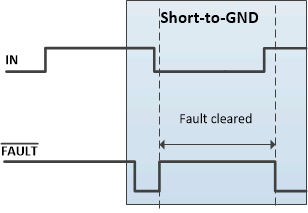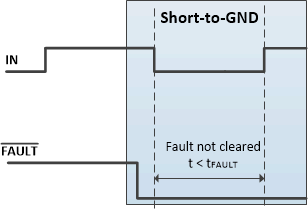SLVSDO6C August 2017 – June 2019 TPS1H000-Q1
PRODUCTION DATA.
- 1 Features
- 2 Applications
- 3 Description
- 4 Revision History
- 5 Pin Configuration and Functions
- 6 Specifications
- 7 Detailed Description
- 8 Application and Implementation
- 9 Power Supply Recommendations
- 10Layout
- 11Device and Documentation Support
- 12Mechanical, Packaging, and Orderable Information
Package Options
Mechanical Data (Package|Pins)
- DGN|8
Thermal pad, mechanical data (Package|Pins)
- DGN|8
Orderable Information
7.3.5.4.3 Fault Report Holding
When using PWM dimming, FAULT is easily cleared by the PWM falling edge. Even if the fault condition remains all the time, FAULT is discontinuous. To avoid this unexpected fault report behavior, the device implements fault-report holding time. Figure 24 shows a typical issue when PWM dimming, the FAULT is cleared unexpectedly even when the short-to-GND still exists. The TPS1H000-Q1 device with fault-report holding function allows the right behavior as shown in Figure 25.
 Figure 24. Without Fault-Report Holding
Figure 24. Without Fault-Report Holding  Figure 25. With Fault-Report Holding
Figure 25. With Fault-Report Holding